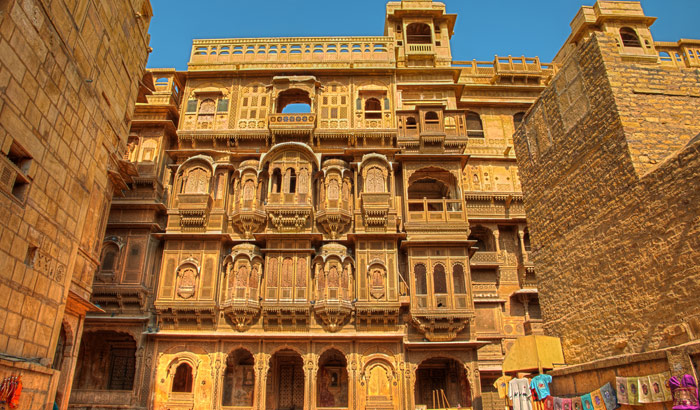- Home
- Rajasthan in India
- Jaisalmer
- Patwon Ki Haveli
Patwon ki Haveli
Quick Facts
Country: India
State: Rajasthan
located in: Jaisalmer.
Attraction: Architecture and miniature balconies
Timings: Early morning till 5 pm
Patwon ki Haveli is one of the most grand and first haveli built in Jaisalmer, Rajasthan. Located close to Patwa complex, this haveli is also known as ‘mansion of Brocade merchants’ as it was constructed by wealthy brocade merchant. Patwon ki Haveli was constructed by five brothers of Jain religion during the period from 1800-1900. The first haveli was constructed by Guman Chand Patwa in the year 1805. He was a merchant by profession.
- Patwon Ki Haveli comprises five interconnected mansions, each constructed for one of Patwa’s five sons. These mansions form a stunning complex.
- The intricate carvings, delicate balconies, and ornate facades showcase the best craftsmanship of the region.
- Imagine a golden honeycomb of opulence rising against the desert landscape!
About Patwon ki Haveli

Each of the five haveli's is very grand and beautiful. It took almost 60 years to construct all the five Haveli’s. Haveli is built on Rajputs culture. Out of the five haveli’s two serve as archaeological survey, one as museum where antique goods are on display last one server as the private accommodation and hence not allowed for public. Patwon ki haveli displays the beautiful architecture and tradition of Jaisalmer. The first haveli which is very grand shows the exquisite work of the craftsmen and the beautiful paintings of the olden times. Patwon ki haveli truly must visit place is Jaisalmer to have a look of the grand work and beauty of the haveli. The haveli is a delight to eyes of the visitors. This historical monument draws thousands of tourists world wide for its beautiful architecture.
Best time to
visit is from October to March. The mansion is open from Monday to Sunday from
9am to 5pm.
Salim Singh Ki haveli

Salim Singh Haveli was constructed in the year 1815 by Salim Singh. The haveli or mansion is famous for its different architecture. It consists of a pavilion at the top and the arches are peacock shaped. The main cupola roof is blue shade. The haveli is built in red sand stone having numerous rooms, corridors and 38 balconies. The architecture is mainly influenced by dancing peacock. The entrance of the Haveli is guarded by tuskers.
It is believed that the haveli had two additional floors in order to make it as tall as the Maharaja’s palace. But however Maharaja removed the top two floors. The haveli is situated in the heart of Jaisalmer close to railway station. The main attraction of the Haveli is the paintings and the architecture. The haveli is open from 8am -6pm. The best time to visit is from October-March.
There are many haveli's in Jaisalmer but these two are considered as important Haveli's of Jaisalmer. other haveli's include Natmalji Ki haveli, Manak chowk ki haveli.

Update on coronavirus in India
Best time to visit
Located in Jaisalmer, it is best to visit the place from November to February. Summer months are very hot and the maximum temperature can hover around 43 degrees Celsius. Winter months are pretty cool and is best time to visit. Jaisalmer has got many other places to visit. One can visit other places on visiting this beautiful haveli.
How to reach
Patwon ki Haveli is easily accessible by road. Tourists can reach Patwon Ki Haveli through Dedanasar Road, High School Road, Sand Dunes Road, Station Road or Jethwai Road.
The Jaisalmer Bus Stand is located about 2.5 kilometers away. The Jaisalmer Airport is located about 9.5 kilometers while the Jaisalmer Railway Junction is located 1.3 kilometers away from the haveli. One can reach Jaisalmer and take a rickshaw to reach the place.
Affiliate Disclosure:
If you make any purchase via a link on this site, I may receive a small commission with no added cost to you.



